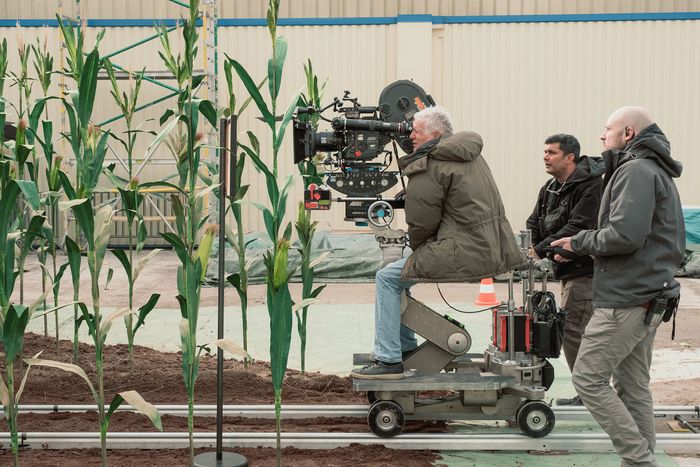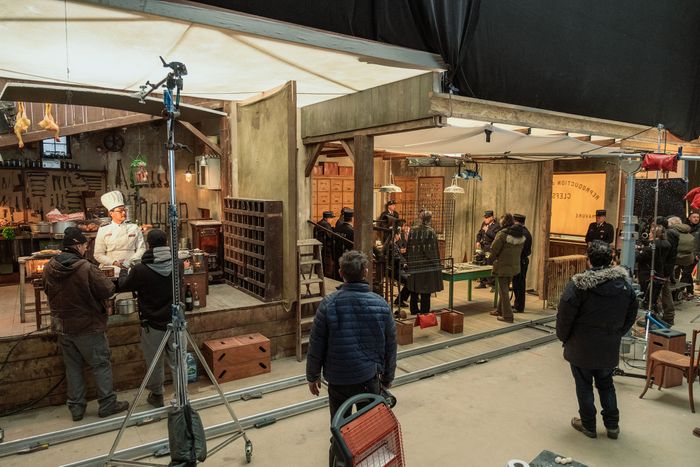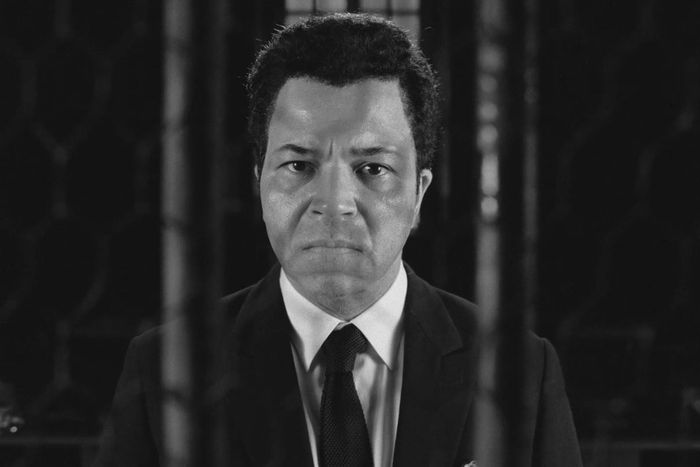“If I didn’t tell you what I did, you’d never know what I did.”
It could be the motto of a legendary stage magician, but it’s actually a quote from Wes Anderson’s key grip, Sanjay Sami. An illusionist of a different sort, his long partnership with the filmmaker recently culminated in The French Dispatch, an anthology of short films about a Sunday supplement to a nonexistent Kansas newspaper, whose final segment features a quietly impossible 70-second tracking shot that Sami describes as “the most complicated shot I’ve ever worked on in my life.”
In addition to the sinuous camera moves scattered throughout the film, Anderson envisioned a showstopper for the movie’s finale, in which feature writer Roebuck Wright (Jeffrey Wright) visits Ennui-Sur-Blase’s chief of police (Mathieu Almaric) to write a profile of his personal chef, Lieutenant Nescaffier (Stephen Park). The tracking shot that ensues takes us through the police station, revealing various rooms, including a shooting range and a gymnasium, ending with Roebuck taking a wrong turn into solitary confinement, where a mobster’s accountant (Willem Dafoe) is being held. The entire time, Roebuck discusses Nescaffier’s cooking — “Police cooking … highly portable, rich in protein, eaten with the nondominant hand only, the other reserved for firearms and paperwork.” In the script, the scene reads like a more controlled and hyperkinetic version of the crane shots in The Life Aquatic that followed Steve Zissou & Co. throughout the bisected Belafonte.
But according to Sami, this shot was much harder to wangle, namely because Anderson wanted to put his camera on rails to shoot it and have that camera do things that a camera on rails can’t do — like zigzag at high speed, and at precisely 90-degree angles, at four different junctures in the shot. The challenge would push the Mumbai-based Sami, a veteran of Bollywood productions who has worked with Anderson for half of his 30-year career, to the limits of his ingenuity.
“When the things we want to do can’t be done with existing equipment, Sanjay designs it and builds it,” Anderson says.
For Roebuck’s scene in The French Dispatch, Anderson told Sami that he wanted the camera to move laterally, seeming to pass through walls as it followed the narrator through the building, then suddenly shift direction at a right angle in order to walk in front of Roebuck, then resume lateral motion again, then do another right-angle move. A long shot of this nature would have been manageable (after a half-day’s rehearsal or so) were Anderson willing to film the scene with a Steadicam, a motion-stabilized handheld camera employed by many a virtuoso director. But Anderson didn’t want to use a Steadicam. He wanted the entire scene to unfold in a single continuous motion. Smooth and tight. No shake, no drift. No cheating. He wanted everything done on dolly tracks because, as Sami puts it, “there is a level of exactness to Wes’s dolly shots that cannot be achieved with a handheld camera, even a Steadicam.”
“The precision Wes demands is so great that you have to put the camera on tracks to get the effect that he wants,” Sami adds. ‘The stability, the rigidity, of a dolly is what makes it a Wes Anderson shot.”
This wasn’t the first time Anderson had asked Sami to work a miracle. The first was when they made The Darjeeling Limited together. Anderson told Sami he wanted to follow his actors up and down a real train, at a variety of speeds, stopping and starting on a dime. Unlike if they were filming on a soundstage in front of a rear-projected or green-screen backdrop, they could not take down their set or drastically modify it to accommodate Anderson’s camera. The train the director picked had hallways the width of a grown man’s shoulders, but Darjeeling was being shot on 35-mm. film in anamorphic wide-screen format, which requires big cameras. They were deep into preproduction when Sami devised a solution: embedding a track of another sort in the middle of the train’s ceiling, running the entire length of the car, to which he could add a makeshift tripod mount that would allow the photographic team led by cinematographer Robert Yeoman to drag or push their camera with the help of a little oil. Easy-peasy.
After that, Sami became Anderson’s resident miracle facilitator. On Moonrise Kingdom, an outdoor scene shot from the point of view of a running dog was accomplished by attaching a lightweight 16-mm. motion-picture camera to a stick, holding the lens at dog height, sprinting with it, then checking the dailies from the lab the following day to see if there was any usable footage. For a 2016 holiday H&M ad starring Adrien Brody — again, on a train, this time double-decker — Sami custom-built lengths of two-tiered dolly tracks in the manner of a wooden toy train so that Anderson’s shots could move in a grid system that required a crew member to manually pull a pin at specific points, turning the end of one piece of track into a dolly platform carrying the camera along on the next length of track. Sami dubbed the contraption the “the Mangalore rig,” after the region of India where he happened to be working while he and Anderson planned the commercial over the phone. The Mangalore rig would never be used again. None of the contraptions that Sami creates for Anderson are ever used again.
“Wes is well aware of the obsessional nature of these sorts of shots,” Sami says. “One time he confided in me, ‘Sanjay, I think my condition might be getting worse!’”
He is certainly becoming more exacting, Sami says. But Sami likes exactness and points out that the increasingly fine-grained requirements of Anderson’s long takes mirror the precision of the language he uses in his screenplays, where every period, comma, colon, semicolon, and em-dash is meant to create a certain emotion or sensation in the mind of the reader. “To me, a stop in a dolly move is a form of punctuation,” Sami says. “When you stop the camera, or slow it down and speed it up again, or do whatever, it’s all punctuation. Going into the shot, Wes knows in a general way how he wants the camera to move, but he doesn’t know exactly how to punctuate it. We have to figure all of that out as we go along. It usually takes Wes six or seven takes to get one of these shots to the point where we can all see what the shot is actually going to be.”
Sami knew the police-station tracking shot would test everyone’s patience. The script describes Roebuck exiting an elevator into a “long, institutional-style corridor in a massive 17th-century building” with “dim overhead light.” And then, after a bit of scene-setting description that’s more literary than technically instructive, the screenplay specifies that “the camera now follows” Roebuck as he “pokes his head into the doorways of various departmental offices” including the “crimes-in-progress center,” a gymnasium packed with police wearing “police-issue exercise leotards performing fitness regimes (pugilist sparring, rope climbing, medicine-ball throwing),” a “marksmanship practice range,” the “disguises checkout room,” and so on.
“When I got to that part of the script, I thought maybe I was reading it wrong,” Sami says, “because there was no way you could do a dolly shot that long and that elaborate without a cut. I wrote an email to Wes and said, ‘It looks like one shot.’ He said, ‘That’s because it is.’”
Anderson told Sami that they could use their old Mangalore rig plans as a starting point for this shot, but with about a hundred meters’ worth of ground to cover, Sami would need to think bigger. Anderson briefly considered building the police-station interior set at the armory where many of the film’s prison scenes had been shot, but he changed his mind and decided to create the entire thing from scratch in four weeks on the production’s principal (makeshift) soundstage, an abandoned felt factory in Angouleme, France. The four-week period “included building the set, designing that set, dressing it, creating it,” says The French Dispatch co-producer Olivia Peissel, and the result “was the length of one entire, crazy stage.” Everything had to be choreographed to happen live within the space — the boxing in the gym, the guns going off in the shooting range — all of the bustle surrounding Wright’s character, Roebuck. The Mangalore-plus would need dollies stacked on top of dollies and pins upon pins to free up pieces of track and achieve the three 90-degree direction changes required to navigate the space.
“You could look at a diagram of how it was done and still not understand it,” says Peissel.
Roebuck begins the final French Dispatch story as a guest on an early-1970s talk show. In interview, he touches on his early years in the city, his first meeting with his editor and publisher, Arthur Howitzer (Bill Murray), his thoughts on being a stranger in a strange land, and, finally, the physical experience of going to the police commissioner’s private dining room to profile a legendary chef — only to end up covering a violent kidnapping. The segment piles on the framing devices (a common feature in recent Anderson films) so that we seem to be inhabiting multiple planes of Roebuck’s consciousness at once. He’s appearing on a talk show in the ’70s at the same time that we’re visualizing the events of his story in the ’60s even as he’s reciting the words of said story from some future vantage point. The information that Roebuck is delivering is about food and the police commissioner’s personal chef, but the visuals that accompany this speak to the scope and power of the police department, which will be unleashed upon the criminal gang that’s about to kidnap the commissioner’s son.
Anderson’s tracking shot through the police station is the moment when all of the exposition that got us to this point starts to recede and his film morphs into a comedic action thriller — at times a borderline caper flick in the vein of Jules Dassin’s 1955 classic, Rififi. “It’s an act of incredible boldness and confidence, shooting the scene the way Wes shot it,” Wright says. “I think it shows Roebuck Wright at the peak of his confidence in the story, reciting from memory, and word-for-word, passages from his best-known magazine piece, for a rapt audience. Most delightfully, he turns the police station, a place that tends to be inhospitable to men such as himself, into a set, almost a playground, that Roebuck Wright is completely in control of.”
But Peissel and co-producer Jeremy Dawson credit Wright with the decision to recite the story within the tracking shot. They say he arrived on set assuming that he was going to speak Roebuck’s lines as a fourth-wall-breaking monologue-in-motion and was disappointed to learn that the lines were intended to be added as voice-over later. “We did the thing a few times with Jeffrey walking through and everybody else doing their thing and then Jeffrey said to Wes, ‘But … I thought we were going to be doing it where I’m just saying the lines,’” Peissel says. “I was sitting there thinking that the way we’d been doing so far was great. Now here was Jeffrey wanting to give it a try in a whole different way. Jeffrey nailed it on the first take.”
“The boom operator, Damien Luquet, was just as impressive,” adds Dawson. “I have a vision of him sort of dancing backward in and out of camera range to keep up with Jeffrey with the camera moving constantly and everybody breaking a sweat.”
Sami speculates that the totality of shots like this, created in collaboration with Yeoman, production designer Adam Stockhausen, and myriad cast and crew members, are the ultimate expression of Anderson’s increasingly animation-influenced aesthetic. The precise, zippy camera moves are directly inspired by shots he was able to do with miniature sets on his stop-motion productions, which would explain why Anderson’s last three live-action features — Moonrise Kingdom, The Grand Budapest Hotel, and The French Dispatch — look like illustrated storybooks come to life. Since 2010, Anderson has supplied his crew with animatics that they then use to translate his scripts into live-action stories. “Our main job now is to match Wes’s cartoons and make the result feel seamless,” Sami explains. “He’s shown us the shot before we’ve done it.”
Of course, molding life to animation is easier said than done. “There are moments where we’re like, ‘That’s it — with this request, he’s lost his block,’” says Sami. “But you just have to accept that Wes is right. Even when he’s completely mad, he’s right. Even if you don’t think he was right on the set, when you finally sit down to watch the full cut and you get to one of those scenes, you invariably think, Oh my God — he was right.”
This article was adapted from an excerpt of Matt Zoller Seitz’s forthcoming book about the making of The French Dispatch.








